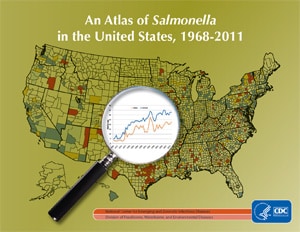National Salmonella Surveillance
National Salmonella surveillance data are collected through passive surveillance of laboratory-confirmed human Salmonella isolates. Clinical diagnostic laboratories submit Salmonella isolates to state and territorial public health laboratories, where they are confirmed and serotyped according to the Kauffmann-White scheme.
Unusual or untypable serotypes are forwarded to the Centers for Disease Control and Prevention’s (CDC) National Salmonella Reference Laboratory at the Enteric Diseases Laboratory Branch (EDLB) for further characterization or confirmation; results are reported back to state and territorial public health laboratories. State and territorial public health laboratories send reports electronically to CDC through a variety of mechanisms.
The Division of Foodborne, Waterborne, and Environmental Diseases (DFWED) in the National Center for Emerging and Zoonotic Infectious Diseases maintains the national Salmonella surveillance data in Laboratory-based Enteric Disease Surveillance (LEDS) system. The annual summaries of these data are the only regularly published national source of serotype information for Salmonella (2). Initially, all surveillance data were transmitted through the Public Health Laboratory Information System (PHLIS), but over time, it has been replaced by the LEDS system. More about Salmonella.
Salmonella Atlas

An Atlas of Salmonella in the United States, 1968-2011 [PDF – 248 pages] is the first-of-its-kind report that charts over 40 years of laboratory-confirmed surveillance data on 32 Salmonella serotypes.
The report includes analyses by age, sex, season, and geography, down to the county level. This is the first time CDC has posted these data online in a downloadable format.
Surveillance Overview
- 2016 [PDF – 87 pages]
- 2015 [PDF – 85 pages]
- 2014 [PDF – 85 pages]
- 2013 [PDF – 89 pages]
- 2012 [PDF – 21 pages], Appendix [PDF – 63 pages]
- 2011 [PDF – 18 pages], Appendix [PDF – 62 pages]
- 2010 [PDF – 19 pages], Appendix [PDF – 62 pages]
- 2009 [PDF – 4 pages], Summary Tables [PDF – 96 pages]
- 2008 [PDF – 5 pages], Summary Tables [PDF – 96 pages]
- 2007 [PDF – 5 pages], Summary Tables [PDF – 93 pages]